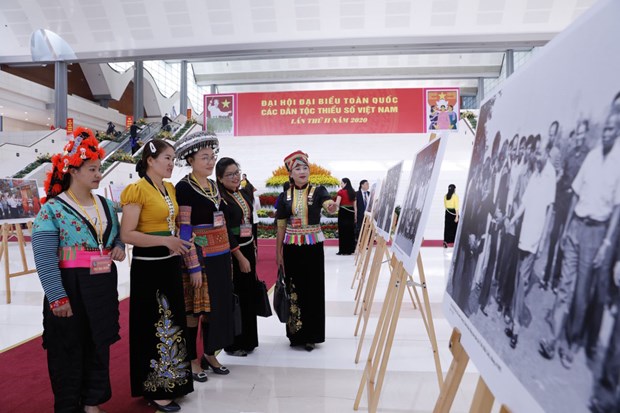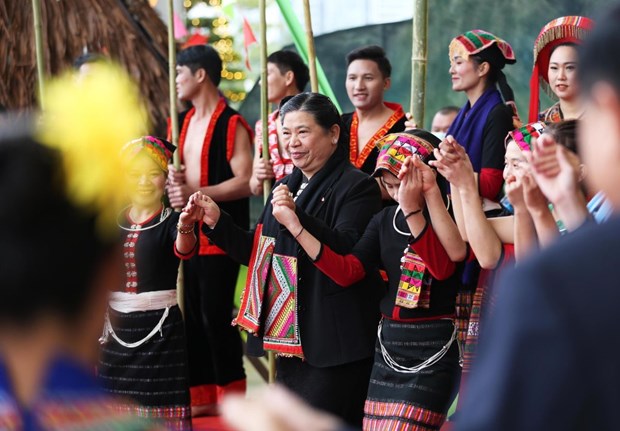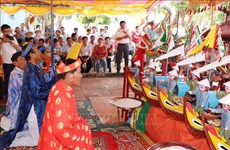Ethnic minority congress: equality, solidarity for development

Hanoi (VNA) – Vietnam has 54 ethnic groups, of which 53 are ethnic minority groups with a combined population of 14.19 million, accounting for 14.7 percent of the national population. Ethnic minority communities live alongside each other in 51 provinces and cities, mostly in mountainous and border regions which face great difficulties in socio-economic development but hold strategic importance in terms of politics, socio-economics, defence-security, external affairs and the environment.
Each ethnic minority group has their own cultural characteristics, creating a national culture of abundance and diversity. Ethnic minority groups are an inseparable part of the Vietnamese nation. They live in harmony and join in the cause for national liberation, construction and defence with loyalty to the Party.
The second national ethnic minority congress was held on December 4 in Hanoi with the participation of nearly 2,000 delegates. The event looked back at a decade implementing a letter of resolve adopted by the first congress, which showed ethnic minority people’s trust in the leadership of the Party and State has unceasingly been consolidated; social harmony has been enhanced and the national unity bloc has grown solid.
The 10-year journey of development
Since the first national ethnic minority congress in 2010, the Party and State have continued to pay special attention to investment in socio-economic development in areas inhabited by ethnic minority groups. Reports from ethnic minority congresses of 363 districts, provinces and cities across the country showed that those areas have seen comprehensive and remarkable achievements in socio-economic development after 10 years implementing the letter of resolve adopted by the first national ethnic minority congress.

Do Van Chien, Minister-Chairman of the Government's Committee for Ethnic Affairs, said administrations at all levels and all sectors have given priority to ethnic minority areas when allocating resources and investment. Essential infrastructure in those areas has been built, local residents’ material and spiritual lives have improved remarkably and poverty rate has been reduced more rapidly and more sustainably.
The official stressed that despite limited financial resources, the Party and State have given priority to ethnic minority and mountainous areas when allocating budget. Under public investment plans and the national target programmes on new-style rural area building and sustainable poverty reduction, tens of thousands of economic and social infrastructure works such as roads, electric transmission and generations facilities, schools, medical stations and cultural houses. As a result, many rural and mountainous areas have been given a facelift with synchronous infrastructure networks, better meeting local residents’ needs in production and daily life.
Meanwhile, the Party Central Committee, the National Assembly and the Government continued to promulgate more policies and laws, mobilizing the involvement of the entire political system and society in the work.
Statistics show 100 percent of districts nationwide have concrete roads to their central areas, 100 percent of all communes are connected with the national electricity grid, and 96.7 percent of all ethnic minority households have had access to electricity. All communes across the country have their own primary and junior high schools, while 99.5 percent have medical stations. Cultural houses or community houses have been built in 65.8 percent of all communes and 76.7 percent of villages.
The household poverty rate in ethnic minority and mountainous areas has been declining at between 2 – 3 percent each year over the past decade, and the reduction is even higher in districts and communes classified as extremely poor, at 3 to 5 percent.
Alongside with economic development and poverty reduction, all-level administrations and sectors continue to pay attention to improving ethnic minority people’s access to education-training, health care, communications, and other public services, thus raising their awareness, knowledge and cultural enjoyment.
In the national cause of Doi Moi (renewal), international integration and development, ethnic minority people have followed the Party’s guidelines, put absolute trust in the leadership of the Party and State, and tapped into their internal resources.
Building the national unity bloc
The important and all-sided achievements of ethnic work over the past 10 years are attributable to the special attention of the Party and State, the engagement of the entire political system and society, and the unity and all-out efforts of ethnic minority groups across the country.

At the second national ethnic minority congress, representatives from ethnic minority groups have expressed their deep gratitude to the Party and the State.
All ethnic minority groups pledged to stay united and follow the Party with the belief that the Party’s leadership will bring a happy life to all Vietnamese, including ethnic minority groups.
Under the Party’s flag, more than 14 million ethnic minority people hold each other’s hands tightly in the resolve to implement the teaching of beloved Uncle Ho: “Kinh or Tho, Muong or Man, Gia Rai or E De, Xe Dang or Ba Na, and all other ethnic minority groups all are Vietnamese, flesh-and-blood brothers. We are always together for life or for death, in happiness or sorrow… Rivers can run dry, mountains can collapse, but our solidarity will never fade.”/.












